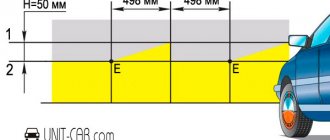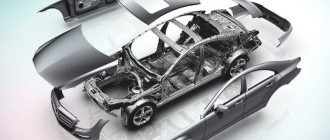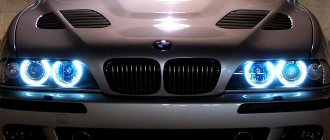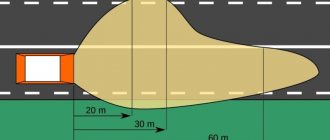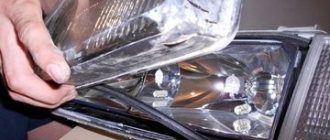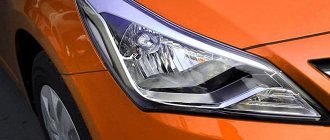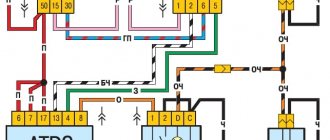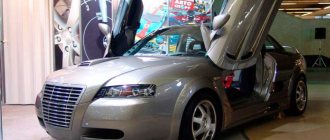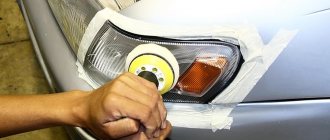What are laser headlights
The new technology was first introduced in the BMW i8 concept in 2011. A few years later, in 2014, the model went into mass production. This was the case when the prototype became a full-fledged production supercar.
Laser headlights
Leading companies in the automotive lighting industry are also developing together with manufacturers: Bosch, Philips, Hella, Valeo and Osram.
This is a complex system with electronic filling that creates a powerful laser beam. The system turns on at speeds above 60 km/h when the car is moving outside the city limits. The city has normal lighting.
Laser light optics device
A relatively new device that appeared in 2014, but has already won the persistent and ardent love of drivers - a laser fog light. They are installed depending on the head optics or side lights.
You can often find them behind a car, and the choice of installation is extensive:
- under the car bumper;
- behind the car directly under the spoiler;
- under the taillights or on the bottom of the car.
Laser lights are good because they are visible to cars driving behind in any weather. As soon as you stop, the instruments leave a bright red stripe that breaks through the darkness and is clearly visible through the rain, thereby telling the drivers of the cars behind that they should also slow down and keep their distance.
The device is small enough in size, and therefore almost invisible, to worry about how harmoniously the device will look on the car.
How do laser headlights work?
The light of laser headlights is fundamentally different from daylight or any other artificial source. The resulting beam is coherent and monochrome. This means that it has a constant wavelength and the same phase difference. In its pure form, it is a point beam of light that is 1,000 times more intense than diode light. The laser beam produces a light output of 170 lumens, versus 100 lumens from LEDs.
Difference in luminous flux
Initially the beam is blue. To produce bright white light, it passes through a special phosphor coating. It scatters a directed laser beam, forming a powerful light flux.
Laser light sources are not only more powerful, but also twice as economical as LED ones. And the headlights themselves are much smaller and more compact than conventional designs.
If we take into account BMW technology, then the fluorescent scattering material is a cubic element filled with yellow phosphorus. A blue beam passes through the element and produces a bright emission of white light. Yellow phosphorus produces light with a temperature of 5,500 K, which is as close as possible to the daylight we are used to. This lighting does not strain the eyes. A special reflector concentrates up to 99.95% of the light flux in the right place in front of the car.
The high beam “hits” up to 600 meters. Other options for xenon, diode or halogen headlights show a range of no more than 300 meters, and on average even 200 meters.
We often associate a laser with something dazzling and bright. It may seem that such lighting will blind people and oncoming cars. It's not like that at all. The emitted stream does not blind other drivers. In addition, such lighting can be called “smart” light. The laser headlight analyzes the traffic situation, highlighting only those areas that are needed. The developers are confident that in the near future, car lighting will recognize obstacles (for example, wild animals) and warn the driver or take control of the braking system.
Igor Vladimirsky - about the Audi R8 sports car with “laser” headlights
I waited until it was dark, drove the Audi R8 LMX supercar onto the German country roads away from Ingolstadt, let everyone oncoming pass, turned on the high beams - and... where is the promised laser light? It works only after 60 km/h, and the illuminated area is almost doubled - up to six hundred meters! It just shines... not quite a laser.
There were oil car headlights, then acetylene, then incandescent, then gas-discharge and LED. And now also laser ones! They appeared almost simultaneously on the BMW i8 and the Audi R8 LMX. The letters LMX are in honor of Le Mans. After all, this year the winning Audi cars were for the first time equipped with “laser” head optics, and now its production version is installed on the road R8 in the “Le Mans” version.
Only 99 of these coupes will go on sale, which differ from the production version V10 plus (AR No. 19, 2013) in a forced engine (570 hp instead of 550 hp), carbon fiber body parts (spoilers, wing, mirror housings, etc.) .d.), sports attributes in the interior and a special blue color. In Germany, the Audi R8 LMX is sold for 210 thousand euros - 35 thousand more expensive than the original V10 plus version. And about half of this additional payment is just for the “laser” light!
Audi R8 LMX headlight beam comparison
Why in quotes?
What is a laser? In short, this is a quantum generator that produces radiation in the optical range with monochromaticity and coherence unattainable for other light sources.
Monochromaticity, that is, the constancy of the color of the beam, is a consequence of a fixed wavelength. That is, the laser beam can be either red, or blue, or... But not white, since white light, which is needed to illuminate the road, is achromatic. White light does not have its own wavelength, and it is obtained as a result of mixing at least three monochromatic radiations (for example, red, green and blue - as in TV picture tubes).
And coherence is the synchronism of wave oscillations at different points in space and at different times. Think of laser pointers that run on regular batteries. The power of such a laser is no more than 5 milliwatts, but the beam hits a couple of kilometers, while only a small illuminated spot is visible on the “targeting” surface.
But for car headlights, on the contrary, you need a source of diffused light to illuminate a large space in front of the car!
Moreover, even cheap laser pointers are dangerous for the eyes: the beam concentrated at one point irreversibly damages the retinal cells. And with increasing power, both leather and even inorganic materials fall into the “risk group”.
So how did engineers from the German company Osram, which developed new headlights for both Audi and BMW, manage to adapt a laser to illuminate the road?
Indirectly. There are lasers in the headlights of the Audi R8 LMX, but their beams do not extend beyond the housings!
See the "laser" light section? And she is! The barrel of the laser-phosphor “gun” (shown by the arrow) is only 2 cm in diameter and is covered with miniature blinds that open at the command of the electronic unit when turned on
Firstly, the head optics here are primarily LED: semiconductor light sources are responsible for both low beam and high beam. But in addition, each headlight also contains four miniature laser diodes with a power of 1.6 W each (the headlights of the BMW i8 have three such diodes - and this is the only fundamental difference from Audi). Lasers generate hair-thin blue rays (wavelength 450 nm). With the help of lenses, these rays are collected into one and... fall on the phosphor - a yellow phosphor plate with an area of only 0.5x0.5 mm. This is the true source of light! Absorbing the energy of laser radiation, it emits a beam of almost white light (color temperature - 5500 K), which falls onto the road through a system of reflectors.
A multi-stage safety system prevents “clean” laser beams from escaping outside, cutting off the power at the slightest damage or “suspicion” of an emergency situation. The blinds in the headlights are also part of this system.
That is, the laser here is only a source of energy, and it would be more correct to call such headlights laser-phosphor. And if you consider that the “laser” section automatically connects to the LED section only after 60 km/h, then... Shame, Osram? But who cares about technical correctness these days? You can’t call these headlights “LED-laser-phosphor”. Long and unclear. And if you say “laser” - and the wow effect is guaranteed!
Which technology is better?
“Today it’s matrix,” Stefan Berlitz, Audi’s chief headlight specialist, answers without a shadow of a doubt.
Herr Berlitz is referring to the Audi Matrix LED optics, which are installed, for example, on the Audi A8 (AP No. 21, 2013): 25 powerful computer-controlled LEDs automatically adjust the shape of the light beam, avoiding dazzling oncoming drivers. Laser phosphor optics cannot do this. But it hits 500-600 meters! And the standard LED headlights of the Audi R8 have a declared range of only about 300 m.
But the LED matrix headlights on the updated Mercedes CLS (AR No. 15-16, 2014) “according to the passport” shine at 485 m, only slightly inferior to the Audi laser headlights.
“Both we and our colleagues from Mercedes have already learned how to make good LED headlights,” explains Stefan Berlitz. “But “laser” light can only boast of long range and miniature size. But we have just started working on it, it will get more interesting!
No doubt. After all, xenon headlights were at first extremely expensive, but now they are a thing of the past. And the future is either LED or phosphor. And definitely bright.
Headlight device
Laser headlights from different manufacturers
Today, this technology is actively implemented by two auto giants: BMW and AUDI.
The BMW i8 has two headlights, each with three laser elements. The beam passes through a yellow phosphorus element and a reflector system. The light hits the road in a diffuse form.
BMW laser headlights
Each laser headlight from Audi has four laser elements with a cross-sectional diameter of 300 micrometers. The wavelength of each diode is 450 nm. The depth of the outgoing main beam is about 500 meters.
Laser headlights of the BMW i8 concept
In light of recent publications (Volvo technology, Mercedes technology), Habr's readers asked for more detailed information about technological innovations in the automotive industry. It seems to me that one of the most interesting and promising developments at the moment is laser headlights from BMW.
In September 2011, BMW introduced new car headlight technology based on the use of blue lasers. This technology was first used on the BMW i8, which was shown at the Frankfurt Motor Show in 2009. The headlight uses not one, but three lasers; there are 12 of them in the car - 3 in each of the 2 sections of the headlight. To understand how this technology works, look at the diagram.
Three lasers (A) are mounted on a triangular shape and shine on small mirrors (B), which redirect the beam to a lens (C). Inside the lens (C) is yellow phosphorus, which emits bright white light when exposed to a blue laser. This light, emitted by the phosphorus, is redirected by the lens onto a reflector (D), which casts the light 180 degrees onto the road in front of the car. The insides of the headlight are created in a special way so that all the light created is reflected onto the surface in front of the car. At the top right of the photo you can see how one of the 6 lasers works, although its beam is blocked by the card. Please note that this configuration is only one of the possible ones and headlights can be made of almost any size and shape.
In this photo you can see the headlights working at full power. BMW says these headlights are 1,000 times brighter than the LED headlights currently used, but use only half the brightness to reduce the car's electricity consumption. Also, company representatives say that the service life of the headlights is at least 10,000 hours, the same as that of LED headlights. Importantly, the ability to resize headlights will allow designers more freedom to create headlight shapes and sizes.
Of course, the first thing we know about lasers is that they do not need to be pointed at anyone's eyes, so as not to damage the retina. With these headlights this is simply impossible, BMW asks you not to worry. The laser is dangerous because its light is very concentrated and focused. The light produced by yellow phosphorus is not the same, and to prove this, the BMW engineer looked directly into the beam of light created by the headlights and invited journalists to do the same. Despite the fact that the headlights are very bright, neither the author of the text nor anyone else was harmed by this demonstration. It also eliminates the possibility that headlights could ignite objects in front of the car (even though the engineer lit an incense stick from one of the car's lasers to demonstrate its power) for the same reason. The light created by the headlight is not a laser beam due to the different nature of the light itself. If you are afraid of lasers that will fly out of the headlights during an accident and begin to destroy everything around you, don’t worry, BMW has taken care of this too, in the event of an accident, just like with xenon headlights, the power supply to the headlights is immediately turned off.
BMW also did not miss the opportunity to introduce the new Dynamic LightSpot system technology, which highlights pedestrians who are in your path. On the technical model that we were shown, these spotlights were built into the foglight mounting position and are driven by a system similar to adaptive cornering lighting. The system uses the same technology as BMW's night vision system, which uses infrared sensors and cameras to recognize a person based on body temperature and silhouette. If the night vision camera indicates a pedestrian with an icon on the entertainment system display, the LightSpot system is more active and illuminates the pedestrian with one beam from the place of the fog lights. Since the car has two fog lights, the car can monitor two pedestrians at once, and it can also keep the light on a pedestrian crossing the road in the dark in front of you.
In order not to be distracted by pedestrians who do not interfere with the movement of the car, the system has a fairly narrow field of view. The computer monitors all pedestrians in front of the car, but the system will highlight only those that will intersect with the car’s trajectory or are in danger of intersecting this trajectory. BMW says the system can move the beam faster than any human can run, so you won't be able to outrun the beam. However, BMW says that the system is still experiencing difficulties on serpentine roads, where the car constantly changes its trajectory. That's why it's still a prototype. Still, the company says the system makes life much easier for drivers and allows drivers to see pedestrians an average of 34 meters earlier than without it. Oncoming drivers will also be spared any glare, because BMW has an Active High Beam system that monitors oncoming traffic and will not allow drivers to be dazzled.
So far, both systems are prototypes. Dynamic LightSpot will reach consumers first, although BMW is not saying when. But perhaps the time will soon come when laser headlights will become as common as halogen or xenon headlights are common today.
Advantages and disadvantages
The advantages are:
- powerful light that does not strain the eyes and does not cause them fatigue;
- The lighting intensity is much stronger than, for example, LED or halogen. Length – up to 600 meters;
- does not blind oncoming drivers, illuminating only the area that is needed;
- consume half as much energy;
- compact size.
Among the minuses, there is only one – high cost. And to the cost of the headlight itself, it is worth adding periodic maintenance and tuning.
Latest technology
You should not think that laser headlights are similar to those installed on the car of the world famous spy James Bond - they are for others and are not capable of setting fire to vehicles that interfere with you with their radiation. It is clear that light sources that are absolutely safe for others will be installed on civilian vehicles, which will simply significantly increase the efficiency of illuminating the road in front of the vehicle. , according to which laser headlights work, it is worth considering their design.
They are based on a unique scattering technology, which is based on the use of a chemical element such as yellow phosphorus - in fact, the laser is used only as a means of providing its glow. Therefore, laser lighting cannot be used to cause harm to others, to the delight of most road users, and to the chagrin of fans of the famous English intelligence officer. If we look at the technology created by , we can see that it uses three blue lasers, which are aimed at a cubic lighting element filled with phosphorus. Within a minimum time after the beam hits it, it begins to emit very bright white radiation, the intensity of which is several times higher than that of other light sources at similar energy costs. Behind the phosphorus light source, the laser headlights have a specially designed reflector that allows them to concentrate up to 99.95% of the radiation on the road.
Video presentation of BMW M4 laser headlights:
Many people who see a cross-section of laser car headlights in front of them begin to doubt whether such technology will cause harm to others - after all, lasers are known for their ability to blind human eyes and even destroy the integrity of some materials with a sufficiently high power of the radiation source. However, specialists from BMW, which was the first to present a prototype of laser headlights, point out that the laser itself is used exclusively to “ignite” the phosphorus lighting element
Therefore, for drivers of oncoming traffic, as well as people encountered near the road, such lighting equipment will be absolutely safe. Even if a car equipped with laser headlights and the integrity of its lights is damaged, the radiation sources will be instantly turned off, which will minimize the danger of such a light source for others.
A few words about how it works
The laser head light will work in close cooperation with a computer, which, guided by data from sensors, will ensure that oncoming cars and pedestrians are not dazzled. Each laser headlight contains three diodes emitting a light beam with a power of about 1 W. The rays are redirected through a system of mirrors to the fluorescent element after the energy is absorbed by the latter, a white glow is released, which is formed into a light beam.
During the development of laser headlights, another new technology emerged called Dynamic Light Spot . This development allows you to detect pedestrians, as well as other obstacles in the path of the car using an infrared camera. Once the system detects an obstacle, it is automatically illuminated with more intense light so that the driver can pay attention to it and safely overcome it. Typically, the driver's prompt appears somewhat ahead of time, that is, before the object is illuminated by the low beam beams. This is necessary in order to protect the driver and give him the opportunity to prepare for certain maneuvers and actions.
